 | |
| no seal on Wikidata: | |
| Upper Palatinate | |
| Capital | regensburg |
|---|---|
| Residents | 1,081,536 (Dec. 31, 2011) |
| other value for residents on Wikidata: 1098378 | |
| surface | 9,691.03 km² |
| other value for area on Wikidata: 9691.03 | |
| no tourist info on Wikidata: | |
| location | |
 | |
The Upper Palatinate is an administrative district in the east of Bavaria. The capital and seat of the government of the Upper Palatinate is regensburg.
Regions
The Administrative region of Upper Palatinate consists of the three independent cities Amberg, Regensburg, Weiden, and the following seven districts: Amberg-Sulzbach, Cham, Neumarkt in der Oberpfalz, Neustadt an der Waldnaab, Regensburg, Schwandorf and Tirschenreuth.
The District Upper Palatinate is administratively the third municipal level in Bavaria as a representation of the municipalities and districts, the district is identical to the area of the government district.
The seat of the administration of the administrative district and the district is regensburg.
The tourist-oriented regional division looks like this:
- The Upper Palatinate share of the Bavarian Forest. The southern parts of this mountain range belong to Lower Bavaria.
- The Naabtal between Regensburg and Windischeschenbach, among others with the Upper Palatinate Lake District near Schwandorf.
- The Upper Palatinate hill country, which includes the west of the Northern Upper Palatinate Forest Nature Park and the Neustadt an der Waldnaab district.
- The Upper Palatinate Jura, which is part of the Upper Palatinate Franconian Alb represents and of Vilseck at the Grafenwöhr military training area to the Danube west of Regensburg.
- The Upper Palatinate Forest from the Naab valley along the Czech border
- The Stone forest (with the Upper Palatinate part of the otherwise only Upper Franconian Fichtelgebirge near Ebnath) north of the Upper Palatinate Jura and south of the Fichtelgebirge. The stone forest covers the western part of the Tirschenreuth district.
- The Pen country, which is also south of the Fichtel Mountains adjoins and includes the eastern part of the Tirschenreuth district.
places

The most important places in the Upper Palatinate are:
- 1 regensburg
 - UNESCO World Heritage Site.
- UNESCO World Heritage Site. - 2 On the mountain
 - Historic old town of the former capital of the Upper Palatinate.
- Historic old town of the former capital of the Upper Palatinate. - 3 Cham
 - The gateway to the Bavarian forest.
- The gateway to the Bavarian forest.

Regensburg Stone Bridge
Amberg city glasses
Cham market square and town hall
- 4 Neumarkt in the Upper Palatinate
 - on the Ludwig Canal.
- on the Ludwig Canal. - 5 Schwandorf
 - Rock cellar labyrinth.
- Rock cellar labyrinth. - 6 Pastures
 - Glass and porcelain factories.
- Glass and porcelain factories.
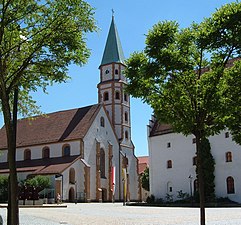
Neumarkt Court Church
.jpg/300px-Schwandorf,_Germany_-_panoramio_(1).jpg)
Schwandorf

Weiden Old Town Hall
Other goals
The Upper Palatinate is particularly interesting for hikers, cyclists and mountain bikers. The deer forest near Amberg is one of the largest contiguous forest areas in Germany. In the valleys of Vils, Naab, Lauterach, Regen, Altmühl and Waldnaab, you can also ride a bike, e.g. B. on the Five rivers cycle route.
The Monte Kaolino is also a special feature Hirschau. A sand mountain about 120 meters high, which arose from the unusable sand from kaolin mining and is the venue for the annual sandboard world championships.
Many neat small towns and villages, some with castles or ruins, also invite you to linger. A nice example is the artist town of Kallmünz at the confluence of the Vils and Naab.
The nature parks of the Upper Palatinate are:
- Northern Upper Palatinate Forest Nature Park
- Upper Bavarian Forest Nature Park
- Upper Palatinate Forest Nature Park
- Steinwald Nature Park
- In the southwest the Upper Palatinate has the city Dietfurt a small part of the Altmuehltal Nature Park.

Waldnaab at Neustadt an der Waldnaab

City parish church with Regenbrücke in Bad Kötzting
background
The landscape of the Upper Palatinate is very varied. From west to east, the Upper Palatinate Jura, an offshoot of the Franconian Alb, with numerous dry valleys and plateaus. Then the Vils and Naabtal with the cities of Amberg, Schwandorf and Weiden and many castles and finally the Bavarian forest with its foothills Upper Palatinate Forest, Steinwald and the Waldnaab Valley.
The name Upper Palatinate comes from the name "Upper Palatinate", as the region was called earlier. In fact, the area belonged to the Palatinate with its capital until the Thirty Years War Heidelberg. The area around Amberg was the so-called Ruhr area of the Middle Ages with abundant iron ore deposits, mining and smelting, which is still evident today in numerous hammer mills in the Vils and Naab valleys. Due to the cheap river shipping to Regensburg, Amberg was able to gain great wealth in the barter of iron for salt, which is still noticeable in the streets of Amberg. Today there are two large military training areas in the USA: Hohenfels and Grafenwöhr. The Upper Palatinate has so far been little touristy and still a very original and authentic region of Bavaria.
regional customs
The Upper Palatinate is part of the cultural area Old Bavaria on the area of the former Electorate of Bavaria with common traditions and customs. A general overview to the old Bavarian customs can be found in the article on Old Bavaria.
language
The Upper Palatinate dialect is a North Baier dialect, the characteristics of which can differ from place to place, so that the dialect of the neighboring village can already differ slightly behind the next hill. Anyone who thinks they are able to speak Bavarian language because they understand the Munich and Old Bavarians will soon notice in the Upper Palatinate that Upper Palatinate differs significantly from the Old Bavarian dialect. The Upper Palatinate contains many diphthongs that differ from the Old Baier dialect. That's why bad tongues tell the joke that if you want to make someone from Upper Palatinate bark, you just have to tell them that there is free beer. He will ask: "wou, wou?" A corpse is found with the words "Dou, dou lichd a Douder dou!" commented.
getting there
In the street
With the automobile preferably via the A 6, A 3 or A 93 motorways. If you are coming from the south, you should exit the A 93 in Regensburg at the Pfaffenstein junction and then drive through the Naab Valley via Mariaort and Kallmünz. It's really worth the drive. The three highways that cross the region are
- the
 (Nuremberg – Neumarkt in the Upper Palatinate – regensburg – Passau),
(Nuremberg – Neumarkt in the Upper Palatinate – regensburg – Passau), - the
 (Nuremberg – On the mountain – Nabburg – Waidhaus - Prague) and
(Nuremberg – On the mountain – Nabburg – Waidhaus - Prague) and - the
 (regensburg – Schwandorf – Pastures - Marktredwitz – court).
(regensburg – Schwandorf – Pastures - Marktredwitz – court).
By train
All major cities in the Upper Palatinate are per train reachable. Long-distance transport to Regensburg or Nuremberg, then local transport. From Nuremberg to Amberg inexpensive with the VGN ticket, from Regensburg to Schwandorf the RVV ticket prices apply. The railway lines run through the Upper Palatinate:
- court – Marktredwitz – Pastures – Schwandorf – regensburg,
- Bayreuth – Pastures,
- Nuremberg – Neukirchen – Pastures or. Nuremberg – Neukirchen – On the mountain – Schwandorf – Cham – Prague and
- Nuremberg – Neumarkt in the Upper Palatinate – regensburg – Passau.
By plane
The next international Airport is in Nuremberg (IATA code: NUE).
By bicycle
With the wheel can be seen from Regensburg on Danube cycle path is very good to drive the rivers upwards into the Upper Palatinate. There are numerous national long-distance cycle paths and a well-signposted network of cycle paths (Bavarian network for cyclists).
Landmarks and World Heritage Sites
UNESCO World Heritage Site
- Old town of Regensburg with Stadtamhof
UNESCO Intangible Cultural Heritage
- Wunsiedler Brunnenfest
- Lace making in the Upper Palatinate Forest
- Further Drachenstich
- Upper Palatinate Zoigl culture
Tourist Attractions
- Valhalla, near Donaustauf east of Regensburg on the Danube.
- Waldsassen Basilica and Monastery. With a famous abbey library.
- Old town of Amberg. Basilica St. Martin, city wall, St. Georg, Maria-Hilf-Bergkirche.
- Old town and city fortifications of Nabburg. Numerous towers, churches and city gates high above the Naab valley.
- Old town and Neunburg Castle in front of the forest. Wittelsbacher residence and historic old town. Birthplace of Beethoven's Elise.
- Schwandorf rock cellar labyrinth. Bavaria's largest rock cellar system of this kind.
- Artist location Kallmünz. In the shadow of a ruin almost built into the rock.
- Klosterburg Kastl. With a medieval coat of arms frieze.
- Fischhofpark in Tirschenreuth
- Bavarian Forest and Upper Palatinate Forest. Gentle mountains with wild and romantic nature.
- Waldnaabtal. Water, stones, forests.
- Schwarzachtal. Untouched, wild and romantic river valley (Natura 2000 area).
gallery
Regensburg, Stone Bridge and Cathedral

Valhalla
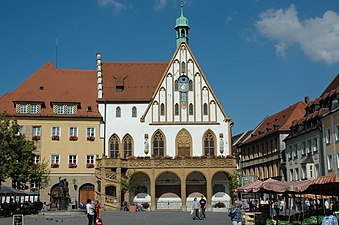
Amberg market square and town hall

Dreifaltikeitskirche Kappl Waldsassen

Kallmünz

Schwandorf

Beer gate in Cham
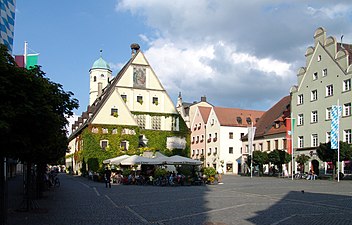
Old town hall in Weiden
Tirschenreuth with Fischhofpark

Wörth Castle on the Danube
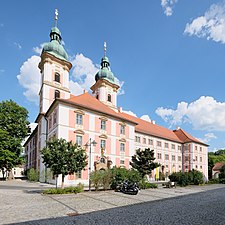
Speinshart monastery village
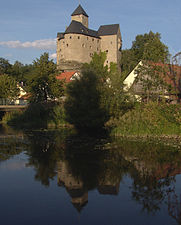
Falkenberg Castle
Land of castles and palaces
In the Upper Palatinate there are 600 Castles and palaces most of Bavaria. These include:
- Falkenstein Castle. The castle that rises above the place of the same name. Every year the courtyard games take place in the courtyard there, and there is also a “Hunting and Game” museum.
- Flossenbürg castle ruins. The wild and romantic castle ruins. Tragically, the place this castle rises above has become famous for something else: the Flossenbürg concentration camp, where around 30,000 people perished.
- Wörth Castle on the Danube. The lock Wörth on the Danube is one of the great castles in the Upper Palatinate. The mighty complex is completely preserved, built in the Renaissance style and has the character of a fortress.
Museums
- Mining and Industry Museum East Bavaria, in Theuern.
- 1 German Button Museum, Tachauer Str. 2, 95671 Bärnau. Tel.: 49 9635 1830, Email: [email protected].
- 2 International Ceramic Museum, Luitpoldstraße 25, 92637 Weiden in the Upper Palatinate. Tel.: 49 961 32030. Open: Mon closed, Tue - Sun 11 a.m. - 5 p.m.
- Upper Palatinate Fishing Museum, in Tirschenreuth.
- 3 Upper Palatinate Open Air Museum Neusath-Perschen, Neusath 200, 92507 Nabburg, Germany. Tel.: 49 (0)9433 2442-0. The museum consists of two sub-museums, the open-air museum in Neusath and the "Edelmannshof" farm museum in Perschen, both of which are approx. 3 km apart.Open: The farmer's museum is open all year round, Tuesday and Thursday 1 p.m. to 6 p.m., Wednesday, Friday and Saturday 1 p.m. to 11 p.m., Sunday 10 a.m. to 11 p.m., the open air museum takes a winter break and is open from March.Price: Adults € 4.50, schoolchildren € 3.00.
activities
Of course hiking and cycling, the Upper Palatinate Seeland in the Schwandorf district with numerous quarry ponds also invites you to swim, sail and water-ski.
Canoeing on the rivers rain, Naab, Schwarzach, Vils and Altmühl are also enjoying increasing popularity. The rivers are rather calm and not deep and often lead through dreamlike landscapes.
kitchen
See also: Eating and drinking in old Bavaria
A lot of what the Bavarian Kitchen has to offer, there is also in the Upper Palatinate. Roast pork and dumplings, white sausage, meat loaf, as well as bratwurst and sauerkraut. The soils of the Upper Palatinate are ideal for growing potatoes, so special specialties are potato dumplings (Spotzn) and potato pancakes (Reiberdatschi or Dotsch) as well as potato dough (Bauchstechala and Schopperla). There are also many game reserves and restaurants with excellent game dishes.
A sweet specialty is lard biscuits made from yeast dough that tastes particularly good when sprinkled with powdered sugar. These include Käichla and Schoitenkäichla. Nussbeugerl is only available in Regensburg - a croissant filled with nuts.
A specialty of the Upper Palatinate is the mirror carp. Especially in autumn you can get it in almost every local restaurant in the most varied of variations. The carp is usually breaded whole and baked in fat (carp baked) or poached in a stock (carp blue).
In the northern Upper Palatinate you should definitely try a Zoigl. A beer that is usually brewed in small quantities in the inns and comes unfiltered from the brew kettle directly into the bottle or on the table. In addition, people meet in good company in the small, rustic village inn to make music and play cards.
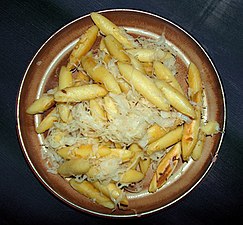
Belly stechala with sauerkraut

Roast pork with dark beer sauce and Spotzn

Bratwurst with sauerkraut in the historical Wurstkuchl in Regensburg

Slaughter bowl
Plate brine

Käichla
.jpg/300px-Nußbeugerl_(Regensburg).jpg)
Nussbeugerl - a Regensburg specialty
Zoigl
carp
The history of carp farming in the northern and central Upper Palatinate goes back almost 100 years. At that time, people began to use cleared forest areas for pond management, which still shapes the landscape today. On the one hand it was about feeding the population with fish, on the other hand also about supplying the local monasteries. In the Middle Ages there were many religious fasting days during the year when meat was not allowed to be eaten. A sufficient supply of fish to the monks was vital on these days. After the decline in demand in the Thirty Years War and the secularization, there was a revival at the end of the 19th century. Today there are around 3,000 farms with around 10,000 hectares of pond area in the Upper Palatinate that operate pond management.
The local gastronomy likes to fall back on the carp from September to April and brings it to the plate in a variety of dishes. As a visitor you shouldn't miss trying the Upper Palatinate fish cuisine. Center of fish farming are Wiesau and Tirschenreuth.

Mirror carp and grass carp (with scales)

baked carp
security
There is a low crime rate across the board in the Upper Palatinate.
health
- nationwide On-call number 116 117 (free of charge)
- Emergency services in the Upper Palatinate: Tel. 01805/191212 (14 cents / min. From the German landline network, cell phones max. 42 cents / min)
- University Hospital With Children's University Clinic in Regensburg
climate
The Upper Palatinate is characterized by a moderate climate with warm summers and snowy winters.
trips
- To the west after Nuremberg in Middle Franconia
- In the south after Upper Bavaria (e.g. Landshut or Munich) and Lower Bavaria (e.g. Straubing or Passau)
- In the east to the Czech Republic, e.g. Pilsen or Prague
- In the north after Thuringia
literature
- : The Upper Palatinate from the air. regensburg: Blow, 2010, ISBN 978-3791722498 ; 128 pages. € 29.90
- : Schäfflertanz & Perchtenlauf, living traditions and customs in old Bavaria. South German, 2009, Süddeutsche Zeitung Edition, ISBN 978-3-86615-729-3 ; 192 pages. 19.90 €
- : Hawa honor! Upper Palatinate in 30 x 2 minutes: An enjoyable Upper Palatinate language course. Pastures: Stangl Taubald, 2009, ISBN 978-3-924783-464 ; 128 pages. € 6.50
- : Upper Palatinate Beer Guide: All breweries, all beers. With excursion and hiking tips. Mz book publisher, 1999, ISBN 978-3931904562 .
Web links
- Administrative region of Upper Palatinate: www.regierung.oberpfalz.bayern.de
- District Upper Palatinate: www.region-oberpfalz.de
- East Bavaria Tourism Association: www.ostbayern-tourismus.de
- Regional marketing Upper Palatinate: www.oberpfalz.de
- www.oberpfalz-luftbild.de











.jpg/300px-Schwandorf,_Germany_-_panoramio_(1).jpg)





















.jpg/300px-Nußbeugerl_(Regensburg).jpg)


